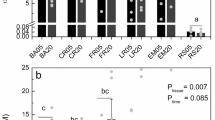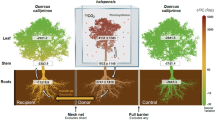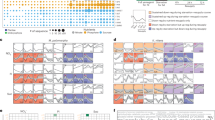Abstract
Multiple ectomycorrhizal fungi (EMF) compete to colonise the roots of a host plant, but it is not known whether their success is under plant or fungal control, or a combination of both. We assessed whether plants control EMF colonisation by preferentially allocating more carbon to more beneficial partners in terms of nitrogen supply or if other factors drive competitive success. We combined stable isotope labelling and RNA-sequencing approaches to characterise nutrient exchange between the plant host Eucalyptus grandis and three Pisolithus isolates when growing alone and when competing either indirectly (with a physical barrier) or directly. Overall, we found that nitrogen provision to the plant does not explain the amount of carbon that an isolate receives nor the number of roots that it colonises. Differences in nutrient exchange among isolates were related to differences in expression of key fungal and plant nitrogen and carbon transporter genes. When given a choice of partners, the plant was able to limit colonisation by the least cooperative isolate. This was not explained by a reduction in allocated carbon. Instead, our results suggest that partner choice in EMF could operate through the upregulation of defence-related genes against those fungi providing fewer nutrients.
Similar content being viewed by others
Log in or create a free account to read this content
Gain free access to this article, as well as selected content from this journal and more on nature.com
or
References
Albarracín MV, Six J, Houlton BZ, Bledsoe CS . (2013). A nitrogen fertilization field study of carbon-13 and nitrogen-15 transfers in ectomycorrhizas of Pinus sabiniana. Oecologia 173: 1439–1450.
Anderson IC, Chambers SM, Cairney JWG . (1999). Intra-and interspecific variation in patterns of organic and inorganic nitrogen utilization by three Australian Pisolithus species. Mycol Res 103: 1579–1587.
Argüello A, O’Brien MJ, van der Heijden MGA, Wiemken A, Schmid B, Niklaus PA . (2016). Options of partners improve carbon for phosphorus trade in the arbuscular mycorrhizal mutualism. Ecol Lett 19: 648–656.
Bever JD . (2015). Preferential allocation, physio-evolutionary feedbacks, and the stability and environmental patterns of mutualism between plants and their root symbionts. New Phytol 205: 1503–1514.
Bever JD, Richardson SC, Lawrence BM, Holmes J, Watson M . (2009). Preferential allocation to beneficial symbiont with spatial structure maintains mycorrhizal mutualism. Ecol Lett 12: 13–21.
Corrêa A, Gurevitch J, Martins-Loução MA, Cruz C . (2012). C allocation to the fungus is not a cost to the plant in ectomycorrhizae. Oikos 121: 449–463.
Corrêa A, Strasser RJ, Martins-Loução MA . (2008). Response of plants to ectomycorrhizae in N-limited conditions: which factors determine its variation? Mycorrhiza 18: 413–427.
Di Rienzo JA, Casanoves F, Balzarini MG, Gonzalez L, Tablada M, Robledo CW . (2012), InfoStat version 2012. InfoStat Group, College of Agricultural Sciences, Nacional University of Córdoba, Argentina. Available at: http://www.infostat.com.ar.
Douglas AE . (2008). Conflict, cheats and the persistence of symbioses. New Phytol 177: 849–858.
Fellbaum CR, Gachomo EW, Beesetty Y, Choudhari S, Strahan GD, Pfeffer PE et al. (2012). Carbon availability triggers fungal nitrogen uptake and transport in arbuscular mycorrhizal symbiosis. Proc Natl Acad Sci USA 109: 2666–2671.
Franklin O, Näsholm T, Högberg P, Högberg MN . (2014). Forests trapped in nitrogen limitation—an ecological market perspective on ectomycorrhizal symbiosis. New Phytol 203: 657–666.
Garcia K, Doidy J, Zimmermann SD, Wipf D, Courty P-E . (2016). Take a trip through the plant and fungal transportome of mycorrhiza. Trends Plant Sci 21: 937–950.
Grelet G-A, Johnson D, Paterson E, Anderson IC, Alexander IJ . (2009). Reciprocal carbon and nitrogen transfer between an ericaceous dwarf shrub and fungi isolated from Piceirhiza bicolorata ectomycorrhizas. New Phytol 182: 359–366.
Grman E . (2012). Plant species differ in their ability to reduce allocation to non-beneficial arbuscular mycorrhizal fungi. Ecology 93: 711–718.
Hammer Ø, Harper DAT, Ryan PD . (2001). PAST: Paleontological statistics software package for education and data analysis. Palaeontol Electronica 4: 9.
Hasselquist NJ, Metcalfe DB, Inselsbacher E, Stangl Z, Oren R, Näsholm T et al. (2016). Greater carbon allocation to mycorrhizal fungi reduces tree nitrogen uptake in a boreal forest. Ecology 97: 1012–1022.
Hoeksema JD, Kummel M . (2003). Ecological persistence of the plant–mycorrhizal mutualism: a hypothesis from Species Coexistence Theory. Am Nat 162: S40–S50.
Högberg P, Högberg MN, Göttlicher SG, Betson NR, Keel SG, Metcalfe DB et al. (2008). High temporal resolution tracing of photosynthate carbon from the tree canopy to forest soil microorganisms. New Phytol 177: 220–228.
Hortal S, Pera J, Parladé J . (2008). Tracking mycorrhizas and extraradical mycelium of the edible fungus Lactarius deliciosus under field competition with Rhizopogon spp. Mycorrhiza 18: 69–77.
Hortal S, Powell JR, Plett JM, Simonin A, Anderson IC . (2016). Intraspecific competition between ectomycorrhizal Pisolithus microcarpus isolates impacts plant and fungal performance under elevated CO2 and temperature. FEMS Microbiol Ecol 92: fiw113.
Kennedy P . (2010). Ectomycorrhizal fungi and interspecific competition: species interactions, community structure, coexistence mechanisms, and future research directions. New Phytol 187: 895–910.
Kennedy PG, Hortal S, Bergemann SE, Bruns TD . (2007). Competitive interactions among three ectomycorrhizal fungi and their relation to host plant performance. J Ecol 95: 1338–1345.
Kennedy PG, Peay KG, Bruns TD . (2009). Root tip competition among ectomycorrhizal fungi: are priority effects a rule or an exception? Ecology 90: 2098–2107.
Kiers ET, Denison RF . (2008). Sanctions, cooperation, and the stability of plant–rhizosphere mutualisms. Annu Rev Ecol Evol Syst 39: 215–236.
Kiers ET, Duhamel M, Beesetty Y, Mensah JA, Franken O, Verbruggen E et al. (2011). Reciprocal rewards stabilize cooperation in the mycorrhizal symbiosis. Science 333: 880–882.
Kiers ET, Rousseau RA, West SA, Denison RF . (2003). Host sanctions and the legume–rhizobium mutualism. Nature 425: 78.
Lilleskov EA, Hobbie EA, Fahey TJ . (2002). Ectomycorrhizal fungal taxa differing in response to nitrogen deposition also differ in pure culture organic nitrogen use and natural abundance of nitrogen isotopes. New Phytol 154: 219–231.
Näsholm T, Högberg P, Franklin O, Metcalfe D, Keel SG, Campbell C et al. (2013). Are ectomycorrhizal fungi alleviating or aggravating nitrogen limitation of tree growth in boreal forests? New Phytol 198: 214–221.
Pena R, Polle A . (2014). Attributing functions to ectomycorrhizal fungal identities in assemblages for nitrogen acquisition under stress. ISME J 8: 321–330.
Pickles BJ, Wilhelm R, Asay AK, Hahn AS, Simard SW, Mohn WW . (2016). Transfer of 13C between paired Douglas-fir seedlings reveals plant kinship effects and uptake of exudates by ectomycorrhizas. New Phytol 214: 400–411.
Plett JM, Tisserant E, Brun A, Morin E, Grigoriev IV, Kuo A et al. (2015). The mutualist Laccaria bicolor expresses a core gene regulon during the colonization of diverse host plants and a variable regulon to counteract host-specific defenses. Mol Plant Microbe Interact 28: 261–273.
R Development Core Team R. (2016). A language and environment for statistical computing. R Foundation for Statistical Computing, Vienna, Austria. ISBN 3-900051-07-0. Available at: http://www.R-project.org.
Rasband WS . (1997) ImageJ. US National Institutes of Health: Bethesda, MD, USA. Available at: http://imagej.nih.gov/ij/.
Sachs JL, Russell JE, Lii YE, Black KC, Lopez G, Patil AS . (2010). Host control over infection and proliferation of a cheater symbiont. J Evol Biol 23: 1919–1927.
Simms EL, Taylor DL, Povich J, Shefferson RP, Sachs JL, Urbina M et al. (2006). An empirical test of partner choice mechanisms in a wild legume–rhizobium interaction. Proc R Soc Lond Ser B 273: 77–81.
Smith SE, Read DJ . (2008) Mycorrhizal symbiosis, 3rd edn. Repr. Elsevier/Academic Press: Amsterdam, Netherlands.
Tedersoo L, May TW, Smith ME . (2010). Ectomycorrhizal lifestyle in fungi: global diversity, distribution, and evolution of phylogenetic lineages. Mycorrhiza 20: 217–263.
Valtanen K, Eissfeller V, Beyer F, Hertel D, Scheu S, Polle A . (2014). Carbon and nitrogen fluxes between beech and their ectomycorrhizal assemblage. Mycorrhiza 24: 645–650.
Walder F, van der Heijden MGA . (2015). Regulation of resource exchange in the arbuscular mycorrhizal symbiosis. Nat Plants 1: 15159.
West SA, Kiers ET, Simms EL, Denison RF . (2002). Sanctions and mutualism stability: why do rhizobia fix nitrogen? Proc R Soc Lond Ser B 269: 685–694.
Wu B, Nara K, Hogetsu T . (1999). Competition between ectomycorrhizal fungi colonizing Pinus densiflora. Mycorrhiza 9: 151–159.
Acknowledgements
Work conducted with the support of an Australian Institute of Nuclear Science and Engineering (AINSE) Research Grant (ALNGRA14531) plus additional funding from the Hawkesbury Institute for the Environment (Western Sydney University) and an Australian Research Council Discovery project (DP160102684). We greatly thank J Berenguel for the design and construction of the chamber used for isotope labelling and J King and C Janitz at the Western Sydney University Next Generation Sequencing Facility for RNA-sequencing services and support. We thank G Skrzypek, D Ford, J Harrison, B Gallagher, G Grelet, B Pickles, C Mitchell, A Bass, M Queralt, R Wright, C Aguirre and G McKenzie for invaluable technical advice and assistance. We also thank F Martin, D Johnson and J Walker for fruitful discussions and suggestions.
Author information
Authors and Affiliations
Corresponding author
Ethics declarations
Competing interests
The authors declare no conflict of interest.
Additional information
Supplementary Information accompanies this paper on The ISME Journal website
Supplementary information
Rights and permissions
About this article
Cite this article
Hortal, S., Plett, K., Plett, J. et al. Role of plant–fungal nutrient trading and host control in determining the competitive success of ectomycorrhizal fungi. ISME J 11, 2666–2676 (2017). https://doi.org/10.1038/ismej.2017.116
Received:
Revised:
Accepted:
Published:
Issue date:
DOI: https://doi.org/10.1038/ismej.2017.116
This article is cited by
-
Improving ectomycorrhizal colonization and morpho-physiological traits of Pinus cooperi seedlings through organic nitrogen fertilization
Mycorrhiza (2025)
-
How mycorrhizal fungi could extend plant cognitive processes
Symbiosis (2025)
-
Community composition of phytopathogenic fungi significantly influences ectomycorrhizal fungal communities during subtropical forest succession
Applied Microbiology and Biotechnology (2024)
-
Mycorrhizal symbiosis and the nitrogen nutrition of forest trees
Applied Microbiology and Biotechnology (2024)
-
Tropical tree ectomycorrhiza are distributed independently of soil nutrients
Nature Ecology & Evolution (2024)



